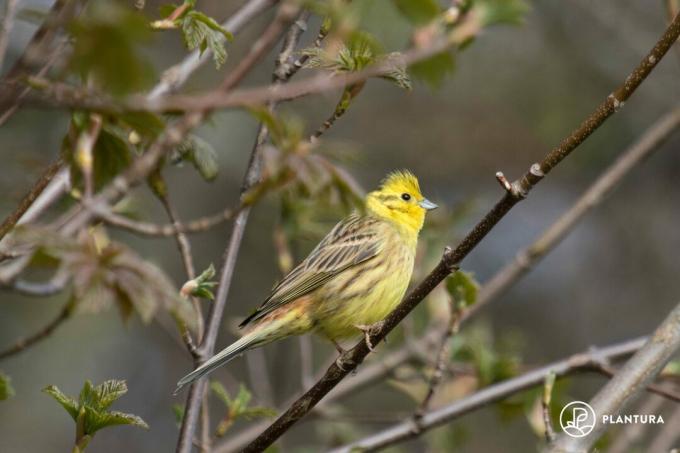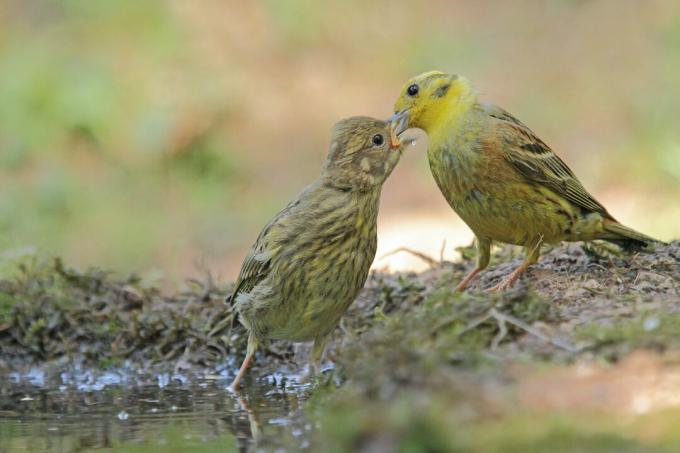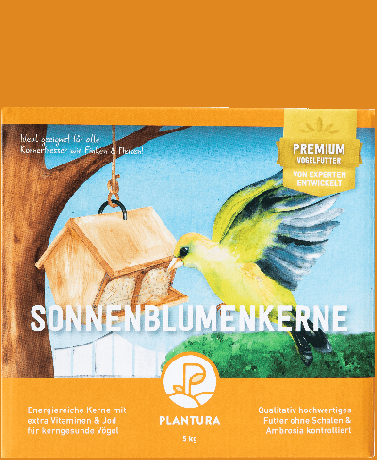What do yellowhammer females and males look like? How can you tell the yellowhammer from the serin? You can find everything you need to know about the nest, food & co. in our profile on the bird.

The Yellowhammer (Emberiza citrinella) lives up to its name. The small yellow and golden songbirds are beautiful splashes of color in the landscape and also enrich their surroundings with their high, lovely song. Yellowhammers have adapted to our man-made cultural landscapes and are therefore also dependent on the preservation of these landscapes. Unfortunately, like many other bird species, they are threatened by changes in use and increasing intensification of these areas, and yellowhammer populations are steadily declining. You can find out here from us how you can clearly identify the "Bird of the Year 1999", distinguish it from the similar-looking Serin and how you can support it in your own garden.
contents
- Yellowhammer: Wanted poster
-
How to recognize the yellowhammer
- How do yellowhammer females and males differ?
- How does the yellowhammer song sound?
- How do you recognize yellowhammer juveniles?
- How do you recognize yellowhammer eggs?
- What is the difference between Yellowhammer and Serin?
- Which habitat do yellowhammers prefer?
- Where does the yellowhammer build its nest?
- When does the yellowhammer breed?
- Where do yellowhammers spend the winter?
-
Support the Goldammer: Here's how
- What does the yellowhammer eat?
- Which nesting aids are suitable for the yellowhammer?
- How can you support the Yellowhammer?
Yellowhammer: Wanted poster
| size | Approximately 16cm |
| Weight | Up to 30g |
| breeding season | April - August |
| lifespan | Up to 10 years |
| habitat | Structurally rich cultural landscapes and forest edges |
| feed preference | seeds, insects and spiders |
| threats | Loss of habitat due to intensification of the cultural landscape |
How to recognize the yellowhammer
Yellowhammers are best recognized during the breeding season when the males show off their bright plumage. Then the olive-brown, black-striped elytra and the long tail of the same color contrast with the bright yellow parts of the head, chest and abdomen. The upper back of the songbird is also marked olive-black, the lower back, also called rump, shines in a strong rusty brown.
How do yellowhammer females and males differ?
Female yellowhammers are a bit plainer than their male counterparts. While the face of the males in the breeding plumage shines completely yellow except for a few black stripes that of the females is more of an olive green to brown color and is only crossed by yellow stripes. The breast of the females is also olive-colored and dashed with black. Only the throat and the belly are lighter and of a dirty light yellow, which cannot compete with the yellow splendor of the males. In the plain dress, however, the male yellowhammers are just as poor in color as their partners.

How does the yellowhammer song sound?
Yellowhammer song is very unique and therefore a good identifier. It consists of a stanza with bright, clear and quickly performed tones, which ends in a long final tone: "Ti-ti-ti-ti-ti-ti-ti-ti-tüüüüüh". In addition to this concise song, the yellowhammer also has a rich repertoire of calls, which are much more difficult to recognize.
You can hear the song of the yellowhammer in the following recording:
How do you recognize yellowhammer juveniles?
Yellowhammer chicks look even plainer than their mothers. The young are of a similar olive-brown base color and already bear the black stripes on the back, tail and elytra. But they lack any yellow accents that make the adult animals so colorful. Only the light, dashed belly gives a hint of yellow.

How do you recognize yellowhammer eggs?
The yellowhammer clutch consists of 3 to 5 eggs, the color of which can vary between bluish, gray and brownish. Dark purple to black spots or scribbles covering the eggs are also typical. The nest built close to the ground consists of stalks, leaves and other plant parts. The nest hollow in which the eggs are laid is carefully padded with soft animal hair.

What is the difference between Yellowhammer and Serin?
Despite their distinctive shape, yellowhammers are easily confused with other bird species. The most common way that such a confusion comes into question is the Serin. This little songbird has a very similar color scheme to the golden bunting, but differs in a few details. First of all, the serin is slightly smaller than the yellowhammer. In addition, its face differs from that of the yellowhammer, as it is marked by a dark, olive-colored cheek patch and a parting of the same color. The yellowhammer males, on the other hand, have an almost pure yellow face. And finally, the rump of the serin described above glows bright yellow, while that of the yellowhammer is rusty brown.

Which habitat do yellowhammers prefer?
Yellowhammers prefer to live in open cultural landscapes, which are nevertheless characterized by structures such as hedges and small trees. They can also be found at the edges of forests if these border open areas. Outside the breeding season, yellowhammers can often be seen in small groups foraging for food in fields and meadows.
Where does the yellowhammer build its nest?
Yellowhammers use protective structures in the landscape such as hedges or bushes as nesting sites. The nest itself is built either directly on the ground in dense vegetation or near the ground in the lower layers of hedges. The female determines which breeding site is best suited for this. However, both partners build the nest.

When does the yellowhammer breed?
Yellowhammers can breed from April to the end of August at the latest. Two, sometimes three, broods are the norm during this period. The eggs are incubated by the female for up to two weeks. The male provides his partner with food during this time. After hatching, the young yellowhammers are initially born naked and blind. They are provided with food in the nest for up to 14 days until they are large enough to leave the nest on their own.
Where do yellowhammers spend the winter?
Our native yellowhammers spend the whole year in Germany and are therefore one of the sedentary birds. However, populations from more northern areas, for example from Scandinavia, sometimes migrate to the south and can then also visit us as winter guests. During this time, the yellowhammers also like to get together in smaller groups to work together to go in search of the scarce food and to each other at the common sleeping place to warm.

Support the Goldammer: Here's how
Yellowhammers – like many other farmland birds – are threatened by the increasing intensification of cultural landscapes. Their existence depends on near-natural, structurally rich fields and meadows. These can be obtained, for example, through organic cultivation methods in agriculture.
But you can also do something good for the yellowhammer in your own garden. Find out everything you need to know about food and nesting aids below.
What does the yellowhammer eat?
Yellowhammers feed primarily on a variety of tree and plant seeds. In the spring and especially for raising their young, they also use a range of insects such as beetles or caterpillars, as well as spiders and other small animals.
If you want to offer additional food in winter to support the golden songbirds in the barren time, you should use grain feed. Sunflower seeds alone or in combination with wild herb seeds also attract yellowhammers to a bird feeder in the cold season. Our plants Sunflower seeds for wild birds are therefore ideal for the small songbirds - the peeled kernels are easy for the birds to pick up, each provides Lots of energy for the cold winter days and, with their extra charge of vitamins and honey, ensure a rich diet.

Plantura sunflower seeds for wild birds
Peeled sunflower seeds
with extra honey, vitamins & iodine,
for winter feeding of wild birds
Which nesting aids are suitable for the yellowhammer?
As free-breeding birds, yellowhammers cannot be impressed with classic nesting boxes. These are more suited to cave breeders like starlings, tree sparrows or great tits. If you still want to offer the yellow songbirds a home, then make sure you have enough undergrowth in your garden. For example, do not thin out hedges and bushes too much to create well-protected nesting sites.
How can you support the Yellowhammer?
Especially during the breeding season, yellowhammers not only depend on seeds, but also on protein-rich insects and other small animals with which they prefer to raise their young birds. A buzzing and lively garden is therefore incredibly important for birds too. With our Plantura beneficial insect magnet you can create a small paradise for a large number of small, useful garden visitors and not only do something good for the birds, but also for your plants.
Also, refrain from using chemical sprays, as these have a negative effect on the garden life and poisoning not only insects but also birds through the food chain be able.
Of course, many other garden birds are also happy about a bird-friendly garden. This is similar to the yellowhammer, for example Goldcrest – as the name suggests – a frequent winter guest in domestic gardens.
...and receive concentrated plant knowledge and inspiration directly in your e-mail inbox every Sunday!

